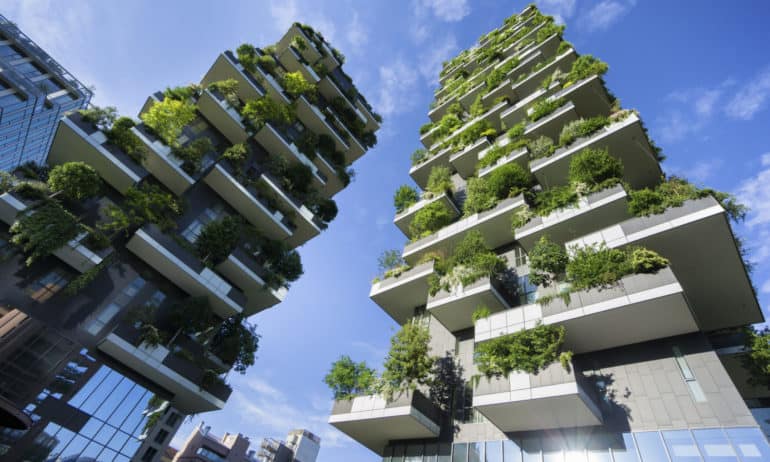Woven Founder Clare Miflin will be speaking at the inaugural New York City Food Tank Summit, “Focusing on Food Loss and Food Waste,” which will be held in partnership with Rethink Food Waste Through Economics and Data (ReFED) and with support from The Rockefeller Foundation and The Fink Family Foundation on September 13, 2017.
Miflin has more than 20 years of architectural experience, mostly from her work at Kiss + Cathcart, Architects —a firm known for their philosophy of “productive” architecture. Having designed buildings to meet LEED, Passive House, and Living Building Challenge rating systems, Miflin sees the importance of rigorous metrics but also feels that inspiration, hope, and vision also have a crucial role to play. In developing the AIANY Zero Waste Design Guidelines for NYC, Miflin applied biomimicry and ecosystems knowledge to develop a coherent vision and specific solutions that are resilient, comprehensive, and inherently connected to place.

Miflin used this experience to found Woven—a consultancy dedicated to weaving together urban and natural systems; metrics and vision; people and place. She is part of the 2016 to 2018 Biomimicry Professional Cohort; volunteers on AIANY’s Committee on the Environment and NYC’s Living Building Collaborative; and is the Sustainability Coordinator for her local food cooperative.
Food Tank spoke to Miflin about her inspiration to apply principles of biomimicry to building designs in an effort to reduce material consumption.
Food Tank (FT): What originally inspired you to get involved in your work?
Clare Miflin (CM): I was moderating a talk called Zero Waste—the Organics Factor about NYC’s new organics collection, and asked a question about whether an architect should provide an organics chute in a new residential building? The panelists had no clear answer, only concerns and questions, and they knew of no buildings with an organics chute. Realizing that few architects would figure this out by themselves, I was motivated to bring a multidisciplinary group of people together to draft design guidelines for architects to help NYC reach its zero-waste goals.
FT: What makes you continue to want to be involved in this kind of work?
CM: As I researched, listened, and understood more about the material systems, I was struck that for most of my career I have been designing to reduce energy and water usage in buildings, but material consumption in buildings is a much larger issue. The food system seems to be the first ‘material’ system where people are starting to consider the full system—from production to distribution to procurement to usage to waste—and its larger consequences. I’d love to work further on how the design of buildings can catalyze change towards circular material loops—for food and other materials. I am studying biomimicry and learning about systems in nature that are so beautifully intricate and interconnected and am inspired to apply this knowledge to human systems.
FT: Who inspired you as a kid?
CM: Heath Robinson / Rube Goldberg machines. My father showing me his ‘spells’ in his biological laboratory and tomatoes in his greenhouse. My botanist mother who took me on ‘fungal forays’ and shared with me her love of plants. The Secret Garden and Danny the Champion of the World books. Jane Goodall.
FT: What do you see as the biggest opportunity to fix the food system?
CM: Supporting and developing local food systems.
FT: Can you share a story about a food hero who inspired you?
CM: When visiting the Science Barge in the Hudson River back in 2007, Viraj Puri (co-founder of Gotham Greens) showed me how when school kids came to visit they would take any food scraps left over from their lunch and put it in a vermicomposter. They’d then take the worms and put them on floating rafts on the aquaponics tank. The fish would eat the worms. The fish poop would fertilize the floating basil and greens growing on the top of the aquaponics tank. The kids would eat the basil and greens for lunch. I was totally inspired by this circular system and how kids were learning about it in a hands-on way.
FT: What’s the most pressing issue in food and agriculture that you’d like to see solved?
CM: I feel that there is not one isolated issue—if we work on changing food systems towards a local model with circular nutrient, energy, and water loops, there will be reinforcing feedback loops, providing increased access to affordable good quality local food, good local jobs in the food sector, reduced social inequity, and much more.
FT: What is one small change every person can make in their daily lives to make a big difference?
CM: Buy local, unprocessed food and eat it all!
The NYC Food Tank Summit is now sold out. Register HERE to watch the livestream on Facebook. A few tickets remain for the Summit Dinner at Blue Hill Restaurant with a special menu from Chef Dan Barber. Apply to attend HERE. If you live in New York City, join us on September 14 for our FREE outdoor dance workout led by Broadway performers called Garjana featuring many great speakers raising awareness about food waste issues. Register HERE.






